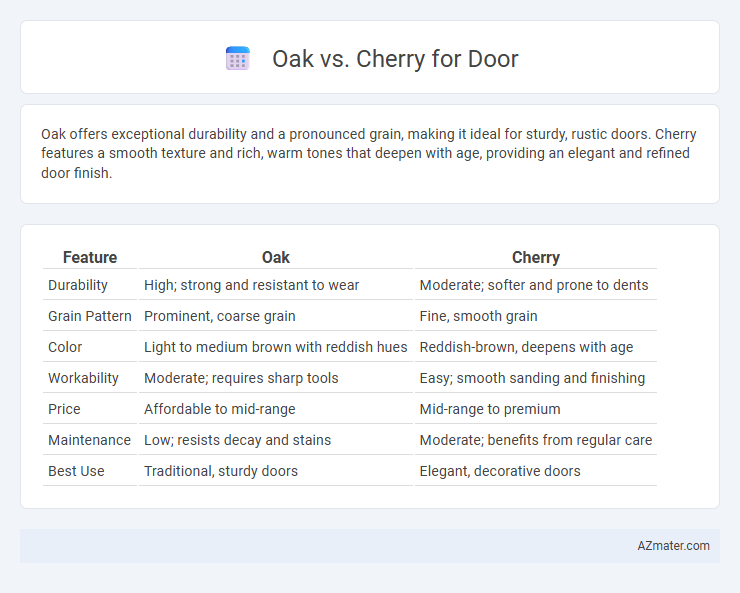Oak offers exceptional durability and a pronounced grain, making it ideal for sturdy, rustic doors. Cherry features a smooth texture and rich, warm tones that deepen with age, providing an elegant and refined door finish.
Table of Comparison
| Feature | Oak | Cherry |
|---|---|---|
| Durability | High; strong and resistant to wear | Moderate; softer and prone to dents |
| Grain Pattern | Prominent, coarse grain | Fine, smooth grain |
| Color | Light to medium brown with reddish hues | Reddish-brown, deepens with age |
| Workability | Moderate; requires sharp tools | Easy; smooth sanding and finishing |
| Price | Affordable to mid-range | Mid-range to premium |
| Maintenance | Low; resists decay and stains | Moderate; benefits from regular care |
| Best Use | Traditional, sturdy doors | Elegant, decorative doors |
Introduction: Comparing Oak and Cherry for Doors
Oak doors offer exceptional durability and a pronounced grain pattern that enhances rustic and traditional interiors, making them a favored choice for high-traffic areas. Cherry doors provide a rich, smooth texture with a warm reddish-brown hue that deepens with age, lending elegance and sophistication to both classic and contemporary spaces. Evaluating factors like hardness, color evolution, and grain pattern helps determine the optimal wood species for specific door applications.
Wood Characteristics: Oak vs Cherry
Oak wood features a coarse, prominent grain pattern and is known for its exceptional hardness and durability, making it ideal for high-traffic door installations. Cherry wood offers a smooth, fine grain with a rich, reddish hue that deepens over time, providing an elegant and warm aesthetic. Both woods have excellent stability, but oak tends to resist dents and scratches better, while cherry wood is prized for its luxurious appearance and ability to develop a natural patina.
Durability and Strength
Oak doors are renowned for their exceptional durability and strength, making them ideal for high-traffic areas and exterior use due to their dense grain structure and resistance to impact. Cherry wood, while aesthetically pleasing with its smooth texture and rich color, is relatively softer and less resistant to dents or heavy wear compared to oak. Choosing oak ensures long-lasting performance and superior structural integrity in door applications where robustness is a priority.
Appearance and Grain Patterns
Oak doors showcase prominent, coarse grain patterns with distinctive swirls and rays, offering a rustic and traditional aesthetic. Cherry doors feature smoother, fine grain with subtle, flowing lines, creating a warm and elegant appearance that deepens in color over time. The choice between oak and cherry hinges on preference for bold texture versus refined, classic beauty in door design.
Color Variations and Aging
Oak doors display a wide range of color variations, from light golden to deep amber hues, which tend to darken and become richer with age. Cherry doors start with a light pinkish tone that gradually matures into a warm, reddish-brown patina, enhancing the wood's natural elegance over time. Both hardwoods offer unique aging characteristics, with oak highlighting its grain through darkening and cherry developing a smooth, glowing finish.
Cost and Availability
Oak doors typically cost more than cherry doors due to oak's greater durability and widespread use in construction, making oak a more economical choice for high-traffic areas. Cherry wood doors, while often pricier because of the wood's luxurious appearance and fine grain, can be harder to find in larger sizes or quantities, affecting availability. Oak is widely available in various grades and finishes, ensuring easier procurement and faster delivery for door projects compared to the more limited supply of cherry wood.
Workability and Installation
Oak doors offer excellent workability due to their hardness and grain structure, allowing for precise cuts and smooth finishes, which makes them ideal for detailed carving and shaping. Cherry wood, while softer than oak, provides easier installation with less risk of splitting or cracking, ensuring faster and more flexible handling during fitting. Both woods perform well, but oak requires more specialized tools and effort, whereas cherry simplifies the installation process.
Maintenance and Longevity
Oak doors offer superior durability and resistance to wear, requiring minimal maintenance due to their dense grain and natural hardness. Cherry doors require more frequent care, including regular polishing and protection from sunlight to prevent fading and warping. Oak's longevity surpasses cherry, making it a preferred choice for long-lasting, low-maintenance door applications.
Best Uses and Style Compatibility
Oak doors offer exceptional durability and a classic grain pattern ideal for traditional and rustic interiors, making them suitable for high-traffic areas like entryways and kitchens. Cherry doors provide a smooth texture with a rich reddish-brown hue that deepens over time, complementing elegant, formal, and transitional decor styles. Oak pairs well with neutral and earthy color palettes, while cherry enhances warm, sophisticated spaces with its distinctive color and fine grain.
Conclusion: Choosing the Right Wood for Your Door
Oak provides superior hardness and durability, making it ideal for exterior doors that require long-lasting strength and resistance to wear. Cherry wood offers a rich, warm appearance with smooth grain patterns, perfect for interior doors where aesthetic appeal and fine finishes are prioritized. Selecting the right wood depends on whether you prioritize toughness and weather resistance (oak) or elegant beauty and fine texture (cherry) for your door application.

Infographic: Oak vs Cherry for Door
 azmater.com
azmater.com